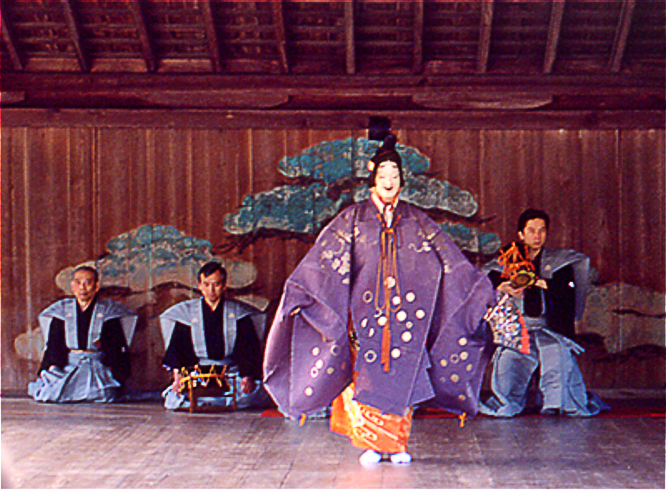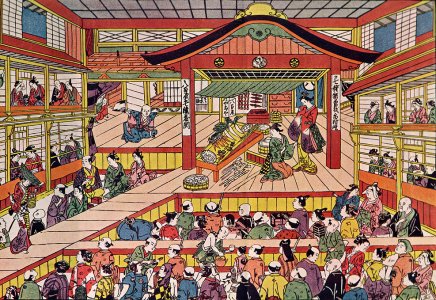I have a serious love for Japanese Theatre. When I did my backpacking trip through Japan last summer I took a lot of time to dedicate to the theatre history of Japan. Like most other countries you can break down traditional Japanese Theatre into a few categories and then expand upon those in order to understand the experiences well.
1. Noh- A slow, religious, poetry based performance piece.
2. Kabuki- A comedic, fast paced, physical based piece.
3. Buhto- A physical dramatic piece usually having to do with the transcendent of the human body and spirit.
4. Bunraku- Traditional Japanese Wooden Puppetry.
Noh
Noh Theatre is the oldest style of theatre in Japan. It is a religous based piece about the spirituality between man and the world beyond typically. The spoken word is done in a flat monotone with the actor wearing masks to divide the man from the audience. Noh theatre is very slow. You cannot go to the show like this expecting a big spectacle.
The musicians are an essential part of the show. They start the show and the audience listens while the actor makes his ten to twenty minute journey to the stage. They play the entire time, some people act as a chanting chorus similar to the chori in the traditional Greek Theatre. They must also play kneeling and sitting on these tiny bamboo lifts. When I saw a Noh piece the chorus members were all older then 50 and one of them needed help getting up after two hours! I think his leg fell asleep, poor guy...
Noh Theatre is a spiritual experience for both the actor and the audience. You are watching a journey of a Japanese spirit, typically. And the spirit goes on this journey typically as human in the first act and then dead as a ghost in the second act. The audience is typically given a binder with the poetry so that they can follow along.
There are 4 character archetypes, they are masked, this is an important distinction if you see a piece that is Noh based but without masks, technically you are seeing Kyogen which is a more modern interpreation of the art.
1. Shite- the human/ghost character. Our protagonist that we watch on his/her journey.
2. Waki- the antagonist
3. Kyogen- the chorus chanters that fill the space between the main action.
4. Hyashi- the four musical performers.
Kabuki
Kabuki is considered a dance/drama of Japan. It's comedic and physical in nature. It has a set that typically has many false walls, trap doors and breakable furniture. The kanji that makes up Kabuki means: sing, dance, skill. You need all of these to be a Kabuki performer. Also 90% of all Kabuki performers are male. This is still an art form where it is considered taboo for a woman to perform as the humor is seen as very manly and crass for a lady to perform. Although, if you go outside the national theatre in Kyoto there is a female Kabuki performer. And they currently have one female Kabuki artist on staff. She's very nice.
The scenery is essential to the comedy of Kabuki as often characters are popping out of boxes, standing on walls that flip around and getting tossed through paper walls. The sets have breakable parts: such as walls and furniture that are put back together between performances. The Kabuki halls are typically very large and lively with a very fun atmosphere. The traps in a Kabuki stage are called the Seri.
Most Kabuki plays are 5 acts long and can go up to 10 hours like the very famous, Jidaimono. They are an event to go to. Families get dressed up in the Yukatas, and sit and enjoy a play. Most are also tea houses and will serve tea to enjoy during the performance. You may enter/exit a Kabuki play freely as they never bring the house lights fully down and due to the long nature of the performance they know people are going to want to get up and pee.
Buhto
Buhto is the most modern of what is called the 4 types of Japanese Theatre. It first appeared in Japan after WW2 as a political uprising to the anger people felt about the war. It is named after Ankuko Buhto, but many people actually dispute the fact that he was the first person to create the style or work in it.
People who study Butoh get very angry at critics who try to define what it is. One student wrote, "The evasion of definition is what makes Buhto what it is." So think of it as the Dadaism of Japanese Theatre. The minute you define it, it's no longer Buhto. Buhto has a lot to do with force. Force or Ki as it's called in Japan can either come from the inside or out and Buhto performers are taught how to train their bodies reaction to force.
Butoh although the hardest to train in and the hardest to define has some of the hippest culture right now in Japan. They have street performers who will dress in cosplay and perform Buhto performances in the street. You'll never see that with Noh!
Bunraku
Bunraku is traditional Japanese puppet theatre. It was founded in Osaka in 1684. All the puppets are hand made and take years to complete just one. Puppet building is a family business that you are trained in from the time you are small, you are not considered a master until the previous one who trained you kicks the bucket.
There are three types of Bunraku performers:
1.Ningyōzukai- the puppeteers
2. Tayu- the chanters
3. Shamisen-the musician. They play an instrument called the Shamisen.
There are typically 3 puppeteers for every puppet. One for the head (which is the head puppeteer and typically the voice of the character), one for the left side and one for right side. Like building puppets in Japan, it is a lifetime dedication to be Bunraku performer.
Like always if you have any questions about Japanese Theatre, feel free to leave a comment and I will get back to you as soon as possible.
This is just a brief overview of all the styles: TRUST ME there is so much more to talk about in each style.



No comments:
Post a Comment